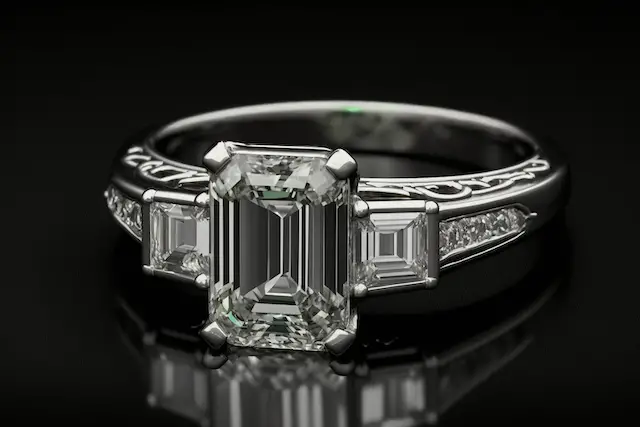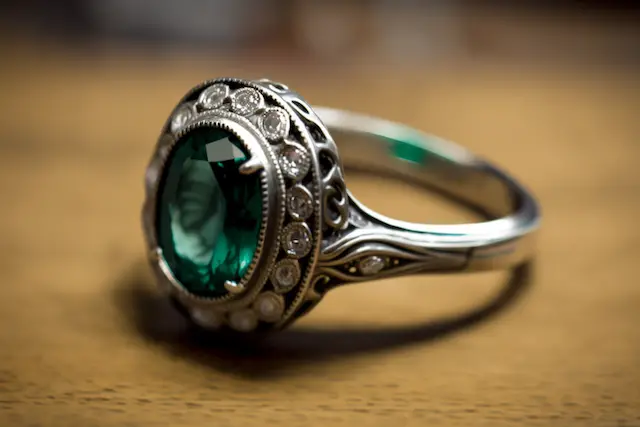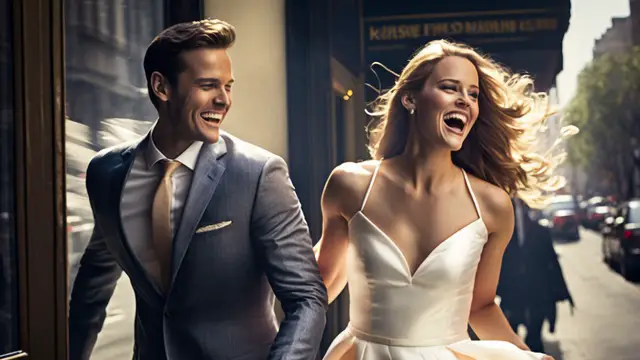Antique and Vintage Engagement Rings: Step Back in Time
For those wishing to travel back through the ages, antique and vintage engagement rings provide a truly one-of-a-kind way to declare your love.
Antique and vintage engagement rings are a stunning choice for couples seeking something special, with plenty of options available from the Georgian era to Art Deco. Antique and vintage engagement rings hold charm and character with their classic designs and romantic history.
Whether you’re looking for a stunning solitaire, a beautiful halo, or a fabulous three-stone ring, there are plenty of choices when it comes to antique and vintage engagement rings.
Not only do these rings provide a sense of romance and nostalgia, but they also tell a story about the couple’s journey together.
Knowing the key differences between antique and vintage engagement rings is the first step in finding the perfect ring for your special occasion.
What are Antique and Vintage Engagement Rings?
While both types of rings are considered “old” by most standards, each type has unique characteristics that set it apart from other styles of rings. For example, antique and vintage pieces often feature intricate hand-crafted detailing not seen in more modern styles.
Antique and vintage engagement rings are also typically made with precious metals and stones, adding to their charm. Antique rings are usually considered those that are at least 100 years old, while vintage pieces may be anywhere from 30-100 years old.
These types of rings can come in a variety of metal colors, such as white gold, yellow gold, rose gold, and platinum. In addition, antique and vintage engagement rings often feature stones that are less seen in modern settings, such as rubies and sapphires.
What is the difference between Antique and Vintage Engagement Rings?
When it comes to antique and vintage engagement rings, the key difference lies in the age of the piece.

Definition of antique engagement rings
An antique engagement ring is defined as a piece that was crafted over 100 years ago. It may have been handmade or machine-made, but it must be older than 100 years to qualify as an antique.
This period includes styles such as Victorian style and older (Georgian era), Edwardian, Art Nouveau, and early Art Deco.
It’s important to note that if a ring has been altered in any way—such as resizing or resetting—it will no longer be considered “antique” according to most standards.
Additionally, many countries have specific laws governing what can and cannot be called “antique,” so it’s essential to understand your country’s definition before making a purchase.

Definition of vintage engagement rings
A vintage engagement ring, on the other hand, is defined as any piece that was crafted within the past 100 years up until around 30-40 years ago.
Art Deco, Retro, and Mid-Century Modern are all considered vintage styles.
Many vintage rings have been reconditioned over time due to wear and tear and can still qualify as “vintage,” depending on the extent of the alterations made by jewelers during the restoration processes.
Generally speaking, it is best practice for jewelers not to alter a piece more than necessary, for it still maintain its original integrity.
The Historical Significance of Antique and Vintage Engagement Rings
Antique and vintage engagement rings hold a special place in history due to their craftsmanship and design style.
They often feature intricate details such as filigree accents or gemstone clusters that give them an unmistakable charm.
Additionally, many of these pieces could have been made during significant periods in history, like World War I or the Great Depression; thus providing insight into what life was like during those times and what style of jewelry was popular at the time.
Advantages of Choosing an Antique or Vintage Engagement Ring
Choosing an antique or vintage engagement ring can be a great way to commemorate your relationship while creating a tangible connection between you and your partner’s shared history.
Additionally, these types of rings are often more affordable than modern-day alternatives since they typically use lower carat weights for their diamonds than newer designs.
Furthermore, finding one-of-a-kind pieces can be much easier because many retailers source their antiques from old estate collections or family heirlooms.
Advantages
- Unique and one-of-a-kind.
- Sustainable and eco-friendly.
- Timeless and classic.
- Rich in history and cultural significance.
- Often more affordable than modern rings.
How Do I Identify Different Periods?
There are telltale signs that can help you identify different periods of antique jewelry, including settings (prongs vs. closed back settings), design elements (filigree vs. pierced metalwork), engraving techniques (hand engraving vs. machine engraving), stones (natural diamonds vs. lab-created diamonds), and metals (yellow gold vs. white gold).
Certain markings or stamps on the inside of the ring (maker’s marks or hallmarks) can also be a helpful indicator of when and where it was made. When researching antique and vintage engagement rings, you can also check the manufacturer’s catalogs to get an idea of when they were made.
Working with an experienced jeweler specializing in antique and vintage jewelry can help you identify the age and era of your chosen piece since they can provide valuable insight into how different pieces were crafted throughout history.

Historical Significance of Antique and Vintage Engagement Rings
These precious gems are steeped in history and romance and will surely become treasured family heirlooms for generations to come.
Engagement rings have been around since ancient times, but it wasn’t until 1477 that Archduke Maximilian of Austria gave the first documented diamond engagement ring to Mary of Burgundy.
This sparked a trend in Europe that soon spread across the globe as more and more people began adorning their fingers with precious stones as symbols of their love and commitment.
Today, antique and vintage engagement rings offer a unique connection to our shared past. They provide insight into the styles of the time, craftsmanship techniques used by goldsmiths, and the cultural influences that shaped jewelry designs over the years.
By understanding the origin of your ring, you’ll be able to appreciate it even more!
The Cultural and Societal Influences on Antique and Vintage Engagement Ring Styles
The style of an engagement ring can tell us a lot about the culture from which it came. During the Georgian period (1714 – 1830), for example, intricate designs featuring multiple precious metals like gold, rose gold, silver, and copper were popular among the aristocracy, while middle-class families favored simpler styles featuring fewer metals.
As time progressed into the Victorian era (1837 – 1901), sentimental motifs became popular as people sought to express their love through elaborate designs featuring hearts, bows, flowers, stars, birds, insects—you name it!
The Impact of Historical Events on Antique and Vintage Engagement Ring Styles
Certain eras also saw drastic changes in design due to major world events such as wars or economic crises. During World War I, for example, most jewelry designers shifted away from ornate styles in favor of geometric shapes like squares or rectangles that used less metal than previous designs—a move intended to conserve resources during wartime.
After World War II ended in 1945, however, tastes shifted back towards fanciful designs as people felt more secure economically and emotionally after years of unrest.
Famous Antique & Vintage Engagement Rings
There are plenty of famous stories behind some iconic antique and vintage engagement rings throughout history! Queen Victoria’s serpent-shaped engagement ring is perhaps one of the most recognizable. At the same time, Elizabeth Taylor’s 33-carat Krupp diamond was famously presented to her by Richard Burton on their fifth wedding anniversary.
Another classic is Princess Diana’s 12-carat blue Ceylon sapphire surrounded by 14 solitaire diamonds set in 18-karat white gold—a stunning timeless piece!
How to Choose the Right Antique or Vintage Engagement Ring
When searching for that perfect antique or vintage engagement ring, there are several essential factors to consider.
First and foremost, think about your personal style – is the ring traditional and classic, modern and unique, or something else entirely?
It’s important to carefully examine the materials used in its construction – diamonds, for example, feature a range of quality grades that can affect everything from their value and sparkle to their clarity.
Make sure the ring fits comfortably by trying on various shapes and sizes.
Take note of any stamps or hallmarks inside that indicate where and when it was crafted.
Lastly, remember to consider its historical significance – this can add a special touch to your purchase.
Keep an eye out for a certificate of authenticity; if one is not available, consult an experienced jeweler for more information about your potential purchase.
Understanding the 4 Cs of diamond grading
When shopping for a diamond, it is important to understand the 4 Cs of diamond grading–cut, color, clarity, and carat weight.
Professional gemologists use these four elements to assess diamonds and determine their value.
When looking for an antique or vintage engagement ring, you should be especially aware of the 4 Cs to ensure you are getting the best quality possible. Here is what each element means in diamond grading:
Cut
Cut refers to the angles and proportions of a diamond and has the greatest influence on its beauty and brilliance. It is judged on symmetry, polish, and finish. The better the cut grade, the more valuable a diamond will be.
Color
The second C stands for color—the less body color there is in a diamond, the more valuable it will be. A rare Perfect D-colorless stone will be more expensive than one with visible yellow or brown tints.
Clarity
Clarity measures how clear a stone is from internal characteristics such as blemishes and inclusions. Stones with less visible imperfections are highly valued. Flawless diamonds (or those with only microscopic inclusions) are very scarce and thus extremely expensive.
Carat Weight
Carat weight simply refers to how large a diamond is—the heavier it is, the greater its carat weight and cost will be. However, since two stones of equal carat weight may have different cuts or clarity grades, they may not necessarily have identical prices.
The Importance Of A Trustworthy Jeweler
Another key factor to consider when choosing an antique or vintage engagement ring is finding a trustworthy jeweler who specializes in estate jewelry and can provide expert advice on what makes an excellent choice for your particular needs and budget.
Your jeweler should be able to answer all your questions about the piece’s age, condition, and estimated value so that you can make an informed purchasing decision.
Additionally, they should offer services such as cleaning and restoration if needed so that the piece maintains its original beauty and value over time.
Tips For Finding The Perfect Antique Or Vintage Engagement Ring
Begin by researching periods of jewelry design, such as Victorian, Edwardian, and Art Deco. This will help you understand the different styles and designs of rings from various eras.
You should also consider your personal preferences regarding size or metal type (e.g., gold versus platinum).
Do some online research first to get a good sense of what pieces are out there before visiting local stores or online shops. This will help ensure that you’ll have the inside scoop on exactly which items to keep an eye out for while shopping.
Finally, don’t forget to factor in any additional costs, such as insurance coverage and resizing fees, prior to making your purchase!
Frequently Asked Questions
How Do I Know If An Antique Or Vintage Engagement Ring Is Authentic?
If you are on the lookout for an antique or vintage engagement ring that is truly authentic, it’s essential to learn how to authenticate one. Here are a few key factors to evaluate when examining a potential purchase:
Age
When searching for the perfect antique or vintage engagement ring, it is essential to consider its age. An authentic antique ring must be at least 100 years old, while a vintage ring must be between 30 and 40 years of age.
Style
Your chosen ring should reflect the prevailing style of its period and have been constructed with materials and techniques used in those times.
Condition
With age comes wear, so look for signs of aging, such as tarnish or fading, when examining the condition of an antique or vintage ring.
Documentation
Ensure that your purchase is genuine with a certificate of authenticity from a reputable jeweler or written appraisal documenting its authenticity.
Materials
Knowing the age, materials, and history of a potential purchase can help you decide when to select an antique or vintage engagement ring!
Are Antique And Vintage Engagement Rings More Expensive Than Modern Rings?
If you’re considering a stunning antique or vintage engagement ring for that special someone, it can be a great way to keep costs down compared to modern rings.
The cost of an antique or vintage piece won’t be influenced by costly production costs, marketing expenses, or retail markup, so it’s often much more budget-friendly.
When shopping for an antique or vintage engagement ring, there are several key factors to consider.
Age is one major factor; the older the ring, the rarer and more valuable it will likely be.
Condition is also important; if components are intact and in their original state, this typically increases the value.
Additionally, luxurious materials like gold or platinum and precious stones such as diamonds usually come with a higher price tag than less pricey alternatives.
The historical significance of the piece should also be taken into account – a unique history can increase its worth while unknown artisans may lend themselves to lower prices than renowned designers and makers.
Furthermore, the designer/maker of the item can greatly affect its overall cost. It’s important to carefully assess each individual antique or vintage ring based on all these criteria in order to find a budget-friendly option without compromising on quality or style!
How Do I Care For My Antique Or Vintage Engagement Ring?
Taking care of an antique or vintage engagement ring is similar to caring for a modern one; yet, it’s best to stay away from severe chemicals and cleaning substances.
Furthermore, antique and vintage rings with their delicate settings and materials make them extremely fragile, making it easier to damage them..
To ensure the longevity of your antique or vintage engagement ring, here are some further tips for optimal care:
• Store the ring in a secure, protective container or box away from direct sunlight, extreme temperatures, and humidity.
• Clean the ring regularly with a soft cloth to keep it free of dirt and grime.
• Avoid wearing your antique or vintage engagement ring while engaging in activities such as swimming, gardening, or any other labor-intensive task.
• Always remove the ring before showering, washing dishes, and applying lotion or perfumes.
• Have your antique or vintage engagement ring professionally inspected once a year to ensure that it is secure and structurally sound.
Interested in finding out more about what styles of engagement rings are popular? Check out our comprehensive guide for everything you need to know!


